In this article, we will discuss the thallus organisation in algae. A wide range of thalli is found in algae, particularly in the vegetative plant body. These diverse forms exhibit a definite spectrum.
On one end, there are simple plants where the thallus body is microscopic and consists of a single cell, such as Chlamydomonas, Phacus, Phacotus, and others. All the morphological structures, cytological, physiological, genetic, and other vital activities occur within this single cell.
On the other hand, there are highly complex types of plant bodies in certain Chlorophyceae, Phaeophyceae, and Rhodophyceae, which can grow very large, sometimes exceeding 60 meters.
These plant bodies exhibit a parenchymatous organization, resembling superficially that of an angiospermous plant. Examples of such complex algae include Ulva, Porphyra, Laminaria, Macrocystis, Nereocystis, and others.
Additionally, there are intermediate stages observed in algae, such as colonial forms like Volvox and Pandorina, palmelloid forms like Tetraspora and Palmella, dendroid forms like Prasinocladus, coccoid forms like Chlorella, filamentous forms like Spirogyra, Ulothrix, Oedogonium, Cladophora, and Pithophora.
Heterotrichous forms like Draparnaldiopsis and Fritschiella, siphoneous forms like Vaucheria and Botrydium, uniaxial forms like Batrachospermum, multiaxial forms like Nemalion and Polysiphonia, and a few others.
These stages demonstrate a definite interrelationship and a range of characteristics, which will be elaborated upon in the comprehensive account below.
Unicellular Type of Thallus Organisation in Algae
Unicellular algae can be found in all groups except Phaeophyceae. They can either be amoeboid and motile or non-motile. Motility is achieved through flagella located at the front end. The number of flagella can vary, usually being two or a multiple of two.
The cells may possess a rigid cell wall or a periplast, which shapes the cell or allows flexibility in shape (rhizopodial or amoeboid type).
Unicellular Non-motile Forms
Unicellular non-motile thalli can be found in various algal groups, including Chlorophyceae, Chrysophyceae, Cyanophyceae, Xanthophyceae, Bacillariophyceae, and Rhodophyceae.
These unicellular organisms have a plant body consisting of a single cell and lack flagella. One well-known example of this type is Chlorella, which comprises microscopic spherical cells containing a nucleus and a cup-shaped chloroplast.
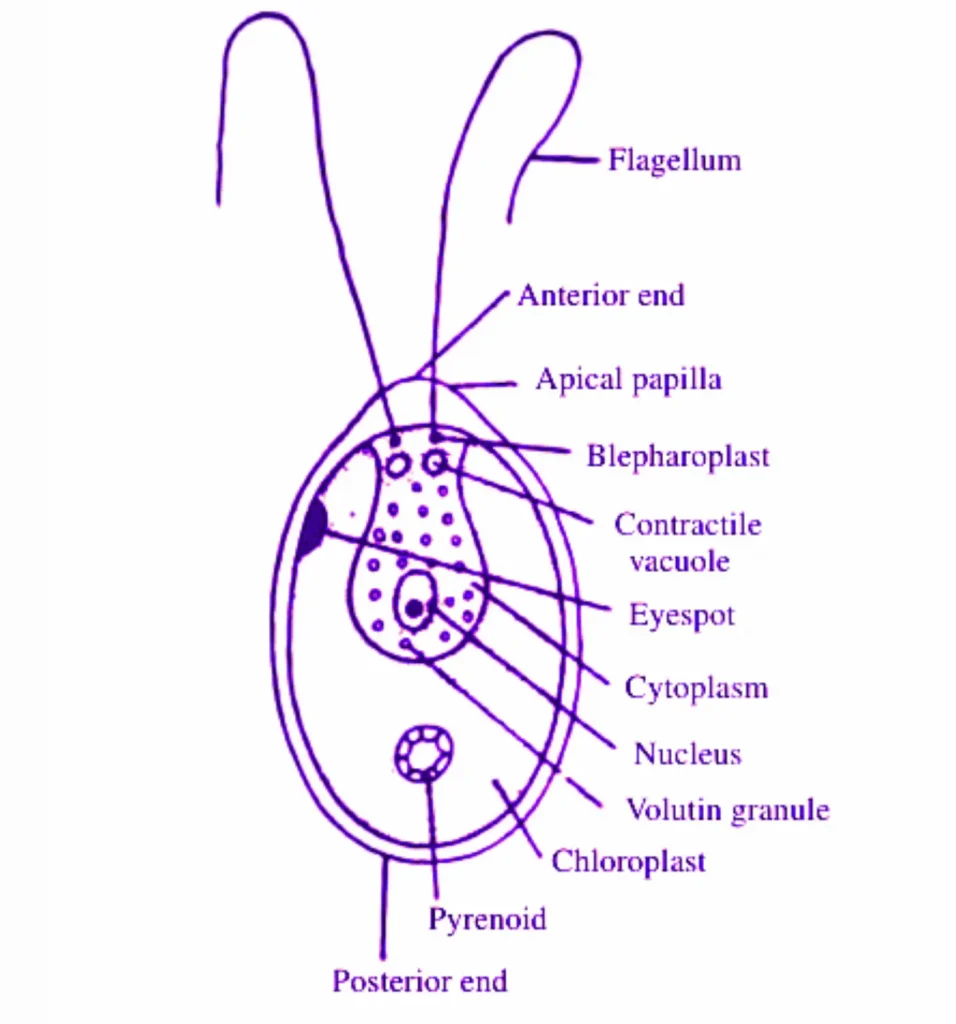
In 1935, Fritsch classified the unicellular non-motile forms as “The Coccoid Habit,” In 1973, Round categorized such forms as the “protococcoidal type” of unicellular organization.
Round also introduced a third category called the “rhizopodial type” within the unicellular organization. These classifications describe various amoeba-like characteristics of these unicellular forms.
Coccoid Form
The plant body comprises small, spherical cells without flagella or movement in unicellular non-motile thalli. Some cells exist individually, while others cluster together in a gelatinous substance.
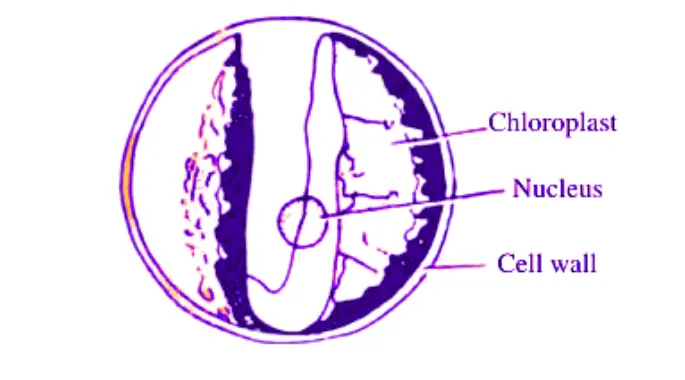
There are also elongated forms with distinct bases and apexes. Unicellular non-motile thalli are found in various algal groups, such as Chlorococcum, Chlorella, Porphyridium, Characiopsis, Gloeocapsa, and Chamaesiphon.
| Algal species | Algal class |
|---|---|
| Chlorella | Chlorophyceae |
| Botrydiopsis | Xanthophyceae |
| Chrysosphaera | Chrysophyceae |
| Tetragonidium | Cryptophyceae |
| Cystodinium | Dinophyceae |
Unicellular Motile Forms
Unicellular motile forms exist in all significant algal groups except Phaeophyceae, Rhodophyceae, Bacillariophyceae, and Myxophyceae.
These forms are distinguished by the presence of a unicellular plant body that possesses means of motility, namely flagella.
One of the most common examples is Chlamydomonas, where the plant body is biflagellated and enclosed within a distinct cell wall.
| Algal species | Algal class |
|---|---|
| Chlamydomonas | Chlorophyceae |
| Heterochloris | Xanthophyceae |
| Chromulina | Chrysophyceae |
| Euglena | Euglenophyceae |
| Cryptomonas | Cryptophyceae |
| Gymnodium | Dinophyceae |
Inside the cell are a cup-shaped chloroplast, one or more pyrenoids, two contractile vacuoles, an eyespot, other cell organelles, and a nucleus.
The unicellular motile forms are of two types: flagellated and rhizopodial.
Unicellular Rhizopodial Form
These algae exhibit an interesting adaptation as they lack flagella, the typical organ of motion. However, they have the remarkable ability to perform amoeboid movement through cytoplasmic growth.
In these rhizopodial unicellular thalli, the protoplast is devoid of a rigid cell wall, which gives them a unique characteristic. Two notable rhizopodial forms are Rhizochloris, found in Xanthophyceae, and Chrysamoeba, belonging to Chrysophyceae.
Unicellular Flagellated Forms
Flagellated unicellular forms can be observed in various classes of algae. These flagellated structures are distinct to certain classes, such as Euglenineae, Cryptophyceae, Chrysophyceae, and Dinophyceae.
However, flagellated vegetative cells are absent in Cyanophyceae, Phaeophyceae, Rhodophyceae, and Bacillariophyceae.
The nature of flagellation, including the type and number of flagella and their attachment, holds significant importance in classification.
In most members of Chlorophyceae, the flagella typically occur in pairs or multiples of two, are equal in size, exhibit a whiplash type of motion, and are attached to the anterior end of the cell.
The unicellular plant body can have different shapes, including spherical, oblong, pear-shaped, and occasionally elongated with an approximately circular cross-section.
Both flagella can be of equal length in certain algae groups, such as Chlorophyceae, while in Xanthophyceae or Dinophyceae, they may be unequal.
The number of flagella can vary, ranging from one in certain Chrysophyceae to four in specific Chlorophyceae.
In certain instances, there may be a separation between the cell’s main body and a peripheral layer, creating a space.
This envelope surrounding the cell is spherical, rigid, and exhibits various shapes. It is also equipped with apertures through which the flagella protrude.
Multicellular Colonial Form
Colonial forms arise from the repeated division of cells and their subsequent aggregation within a mucilaginous mass. Based on their morphology, colonial organizations can be classified into the following Two types:
- Coenobial Forms
- Aggregated forms
Flagellated Coenobial Forms
These are colonial members of algae in which the individual cells possess flagella for motility. These colonies consist of numerous cells. A colony with a specific number of cells and maintaining a constant shape and size is called a coenobium.
Multicellular motile forms can be found in several Chlorophyceae, Chrysophyceae, and Dinophyceae genera. One prominent example of such forms is Volvox, where several cells (ranging from 500 to 50,000) are interconnected through protoplasmic connections.

The coenobium of Volvox is hollow and spherical, featuring a single layer of cells arranged around the periphery. All the cells within the coenobium exhibit a Chlamydomonas structure.
Some additional examples of “multicellular flagellated” or “colonial forms” include Ceratium and Gonyaulax from Dinophyceae, Synura and Chlorodesmus from Chrysophyceae, and Eudorina, Pandorina, and Gonium from Chlorophyceae.
Non-Flagellated Coenobial Forms
In this particular habit, algae exhibit several cells, forming a coenobium. These cells are non-motile and lack flagella or any other means of motility.
One well-known example of non-flagellated multicellular forms is Hydrodictyon, where the network cells remain connected in groups of 5 or 6, forming pentagonal or hexagonal structures.
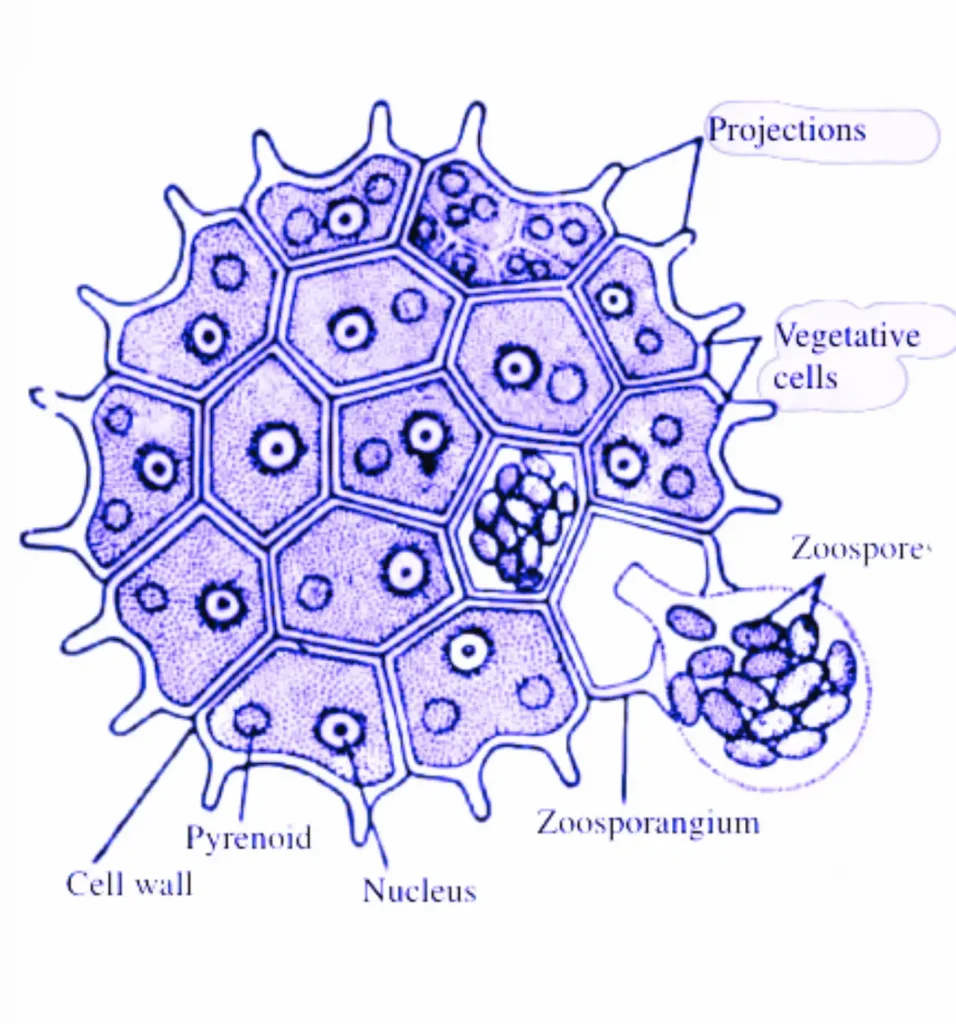
This colonial habit is predominantly observed in Chlorophyceae, such as Pediastrum, Scenedesmus, Coelastrum, and others. The non-flagellated colonial habit likely emerged through the aggregation of unicellular non-motile cells.
Aggregated Forms
Aggregates are formed through the gathering of individual cells to create a thallus. Unlike a coenobium, the aggregation of cells does not have a fixed number of cells, shapes, or sizes.
The cells are clustered together in a colony-like mass, which tends to have an irregular shape. The daughter cells remain within the same gelatinous mass when cell division occurs. As a result, the number of cells increases following division. These aggregates can take on various forms, such as palmelloid, dendroid, and rhizopodial.
Aggregated forms can be classified into Palmelloid, Dendroid, and Rhizopodial colonies.
Palmelloid Forms
These colonial algae members exhibit a characteristic of ” non-motile cells embedded in an amorphous gelatinous” or mucilaginous matrix (Bold and Wynne, 1978).
In palmelloid forms, neither the number nor the shape and size of cells remain constant. The cells aggregate within a standard mucilaginous envelope. Each cell functions independently, performing all the necessary functions of an individual organism.

In Chlamydomonas and Chromulina, the cells lose their flagella, undergo successive divisions, and form 8, 16, or more cells enveloped by mucilage. They resemble the genus Palmella and represent the palmelloid stage.
However, this is a temporary feature in their life cycle because, under favourable conditions, the mucilage dissolves, releasing all the cells.
The mucilage in palmelloid forms is either secreted by the protoplasts of the cells or formed through the gelatinization of their membranes.
Dendroid Forms
The term “dendroid” refers to a tree-like appearance. In genera such as Prasinocladus, Ecballocystis, Ecballocystopsis, and others, the plant body exhibits a microscopic tree-like structure.

In these cases, the mucilage is typically localized, mainly at the base of the cells. This polarity in the distribution of mucilage is characteristic of dendroid forms.
Rhizopodial Forms
A variable number of amoeboid cells come together through cytoplasmic projections, forming root-like structures known as rhizoids.
This type of multicellular form is observed in Chrysidiastrum, a member of the Chrysophyceae.
Multicellular Filamentous Form
Cell division forms multiple daughter cells, separated by septa and sharing common lateral walls inherited from the mother cell.
The filamentous habit has evolved from the motile unicellular habit. When a motile swarmer settles on a substrate, it secretes a cell wall and undergoes division, forming a filament. This filamentous organisation is common among various types of algae.
Filaments can be either branched or unbranched.
Branched Filaments
Branched filaments are formed through successive transverse divisions of lateral outgrowths from cells. The branching of filaments can be categorized as Simple Branched, Heterotrichous, and Pseudoparenchymatous.
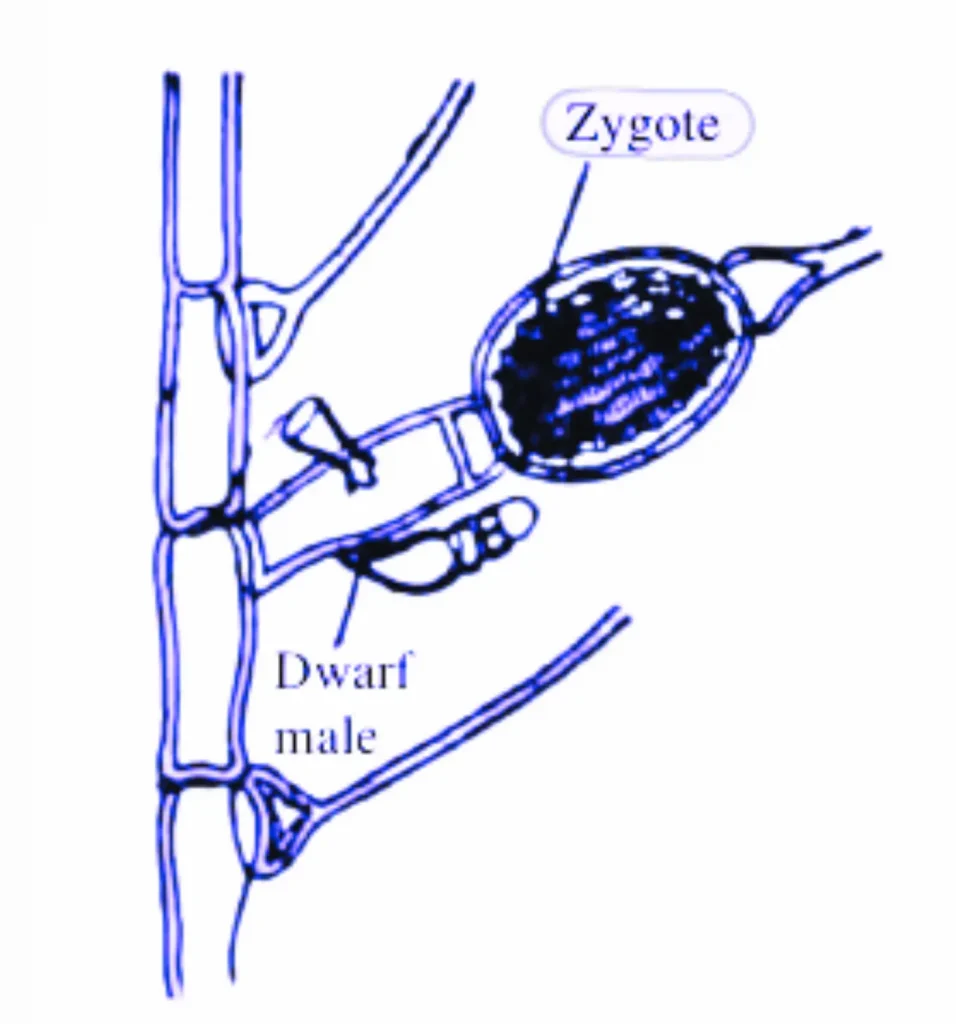
Simple Branched
Many types of algae exhibit a common feature of a simple branched filament with a single row of cells and a basal attachment called a holdfast or hapteron. This can be observed in organisms like Ulothrix and Oedogonium.
In some cases, the branches emerge directly below the cross walls, and the growth and divisions are confined to the end cells of these branches. Cladophora shows an example of this pattern.
Simple branched filaments are also observed in Xanthophyceae and Chrysophyceae. On the other hand, Cyanophyceae exhibit a distinctive form of branching known as “false” branching, exemplified by organisms like Scytonema.
Heterotrichous type of Thallus Organisation in Algae
The term “heterotrichous” is derived from “hetero,” meaning different, and “trichous,” referring to trichome or filament. In certain algae, the plant body has evolved to include more than one type of filament, giving rise to the heterotrichous habit.
This characteristic feature is commonly found in the order Chaetophorales of Chlorophyceae, with examples such as Draparnaldia, Stigeoclonium, Draparnaldiopsis, and Fritschiella. It is also observed in some Phaeophyceae (Ectocarpus, Tilopteris), Rhodophyceae (Erythrotrichia), Myxophyceae (Chaemosiphonales), and Dinophyceae (Dinoclonium).

Typically, the plant body consists of a prostrate system from which an erect system of filaments (referred to as the primary projecting system) develops. This primary system may further divide into numerous branches, forming secondary and tertiary projecting systems.
The heterotrichous habit is believed to have evolved from the filamentous habit through the specialization of filaments.
Unbranched Filaments
Unbranched filaments are observed in various algae such as Spirogyra, Zygnema, Mougeotia, Ulothrix, Oedogonium, Nostoc, Oscillatoria, Lyngbya, Phormidium, Anabaena, Spirulina, many other members of Chlorophyceae, Myxophyceae, Xanthophyceae, and so on.
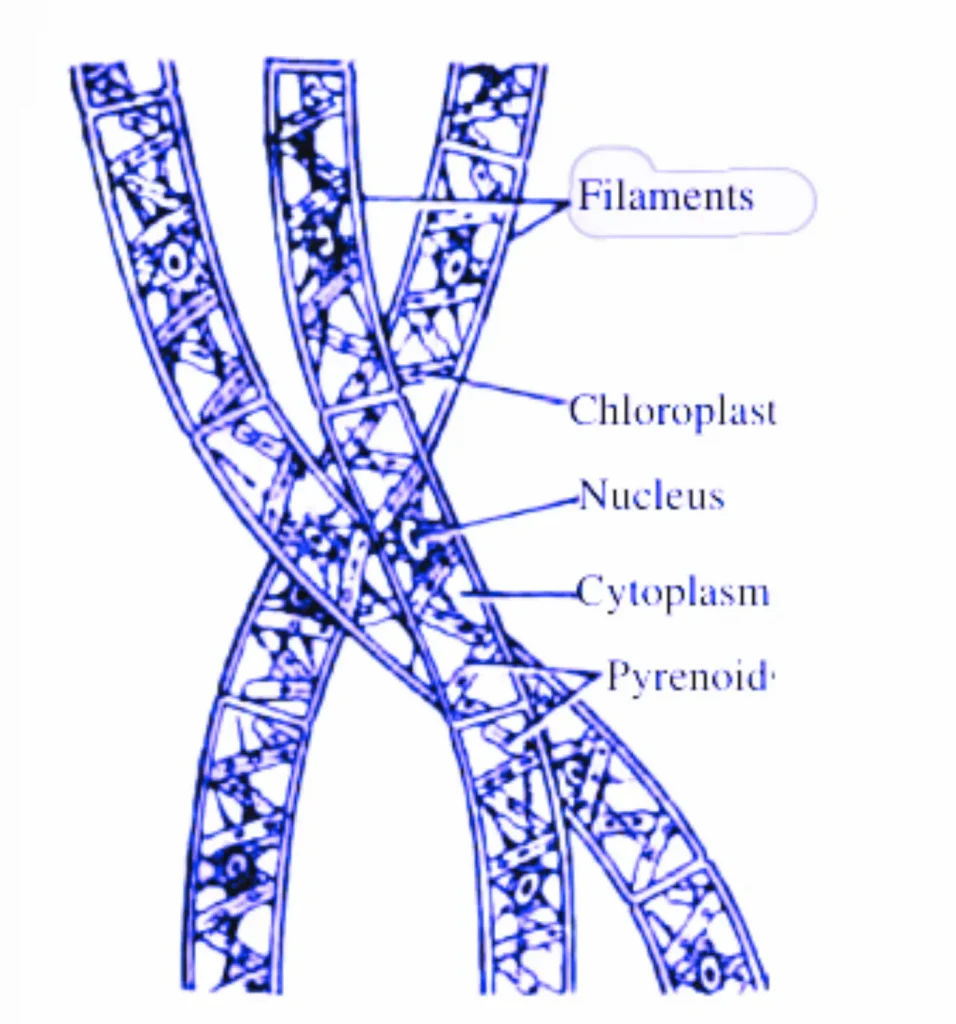
In species like Ulothrix and Oedogonium, the filaments remain attached to the substrate through a specialized basal cell, while in Zygnema, Spirogyra, and others, they are free-floating.
Pseudoparenchymatous
In certain filamentous forms, a parenchyma-like structure is formed by one or more central or axial filaments along with their branches.
Pseudoparenchymatous algae can exhibit different degrees of cell cohesion. In some species like Dumontia in the Rhodophyceae, the cells are densely packed and firmly connected through secondary intercellular connections, resulting in a strong coherence of the thallus.
On the other hand, in species like Castanea in the Phaeophyceae, the association is looser, and the component filaments can be easily separated by applying pressure.
Pseudoparenchymatous thalli can be classified into two types: uniaxial and multiaxial.
Uniaxial Form
The term “uniaxial” in the context of Rhodophyceae refers to a single main axis in the pseudoparenchymatous thalli. In these algae, such as Batrachospermum and Dumontia, the plant body is composed of a main axis with side branches.
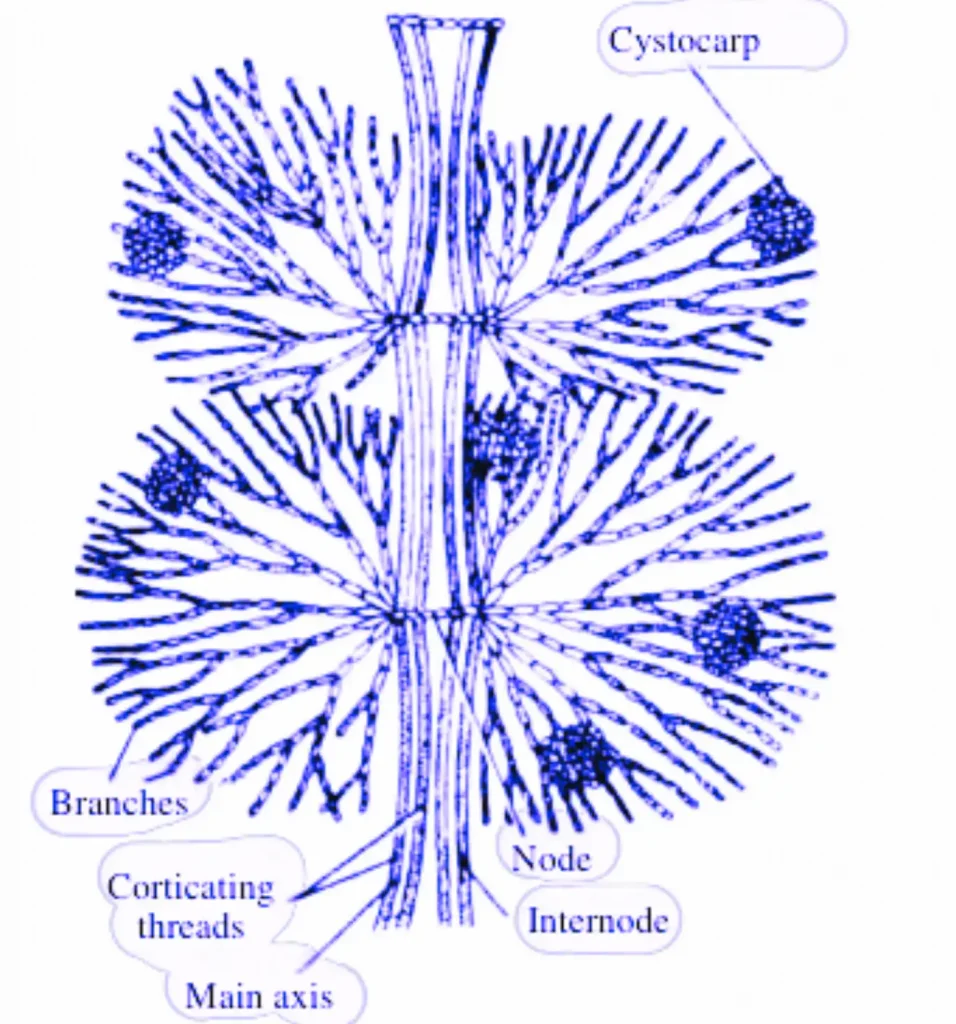
According to Fritsch’s classification, the side branches are closely juxtaposed to the main axial thread, forming the thallus.
The development of the uniaxial form of thalli is believed to have originated from the filamentous habit during evolution.
Multiaxial Form
The term “multiaxial” refers to a thallus construction in certain algae where multiple threads or axes are closely juxtaposed, giving the appearance of more than one axis.
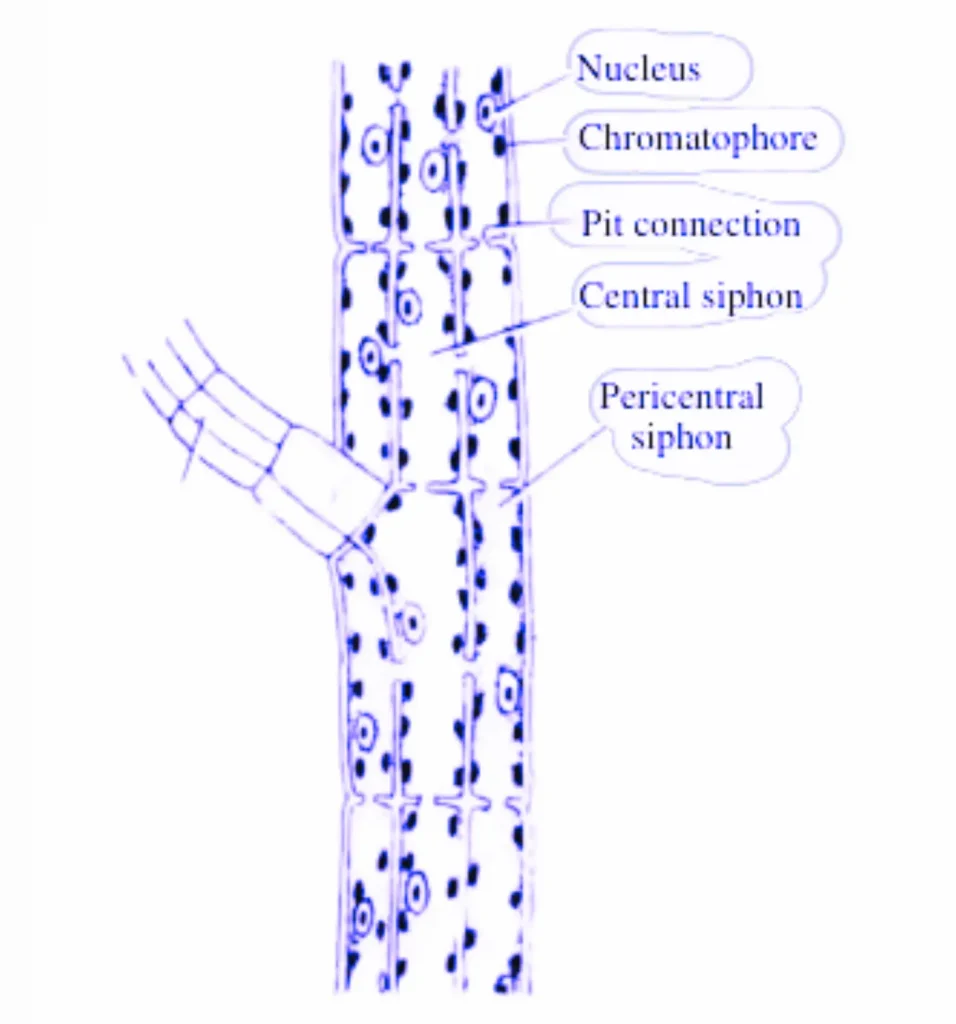
Different filaments from the central and side axes form a compact cortex in this type of thallus. Examples of algae exhibiting a multiaxial construction include Polysiphonia, Nemalion, Scinaia, Chondrus, and Codium.
Siphonaceous Forms of Thallus Organisation in Algae
The plant body undergoes significant enlargement in certain algae without forming septa, resulting in a coenocytic organisation due to multiple nuclei. These algal thalli are referred to as siphonous forms.
They are primarily found in some Chlorophyceae and Xanthophyceae. A prominent characteristic of siphonous forms is the presence of a large central siphon-like vacuole within the thallus, which gives them their name.

Vaucheria is a well-known example of a siphonous alga, where a coenocytic plant body encloses a siphon-like vacuole. Other siphonous genera include Botrydium, Valonia, Codium, Bryopsis, and Dasycladus.
According to Fritsch (1935), siphonous forms are “multicellular plants that lack the typical septa formation.
Parenchymatous Forms
In certain algae, extensive septation of a filament in multiple planes leads to forming a “parenchymatous” body. These plants can exhibit a variety of forms, such as foliose and flat (e.g., Ulva) or tubular (e.g., Enteromorpha).
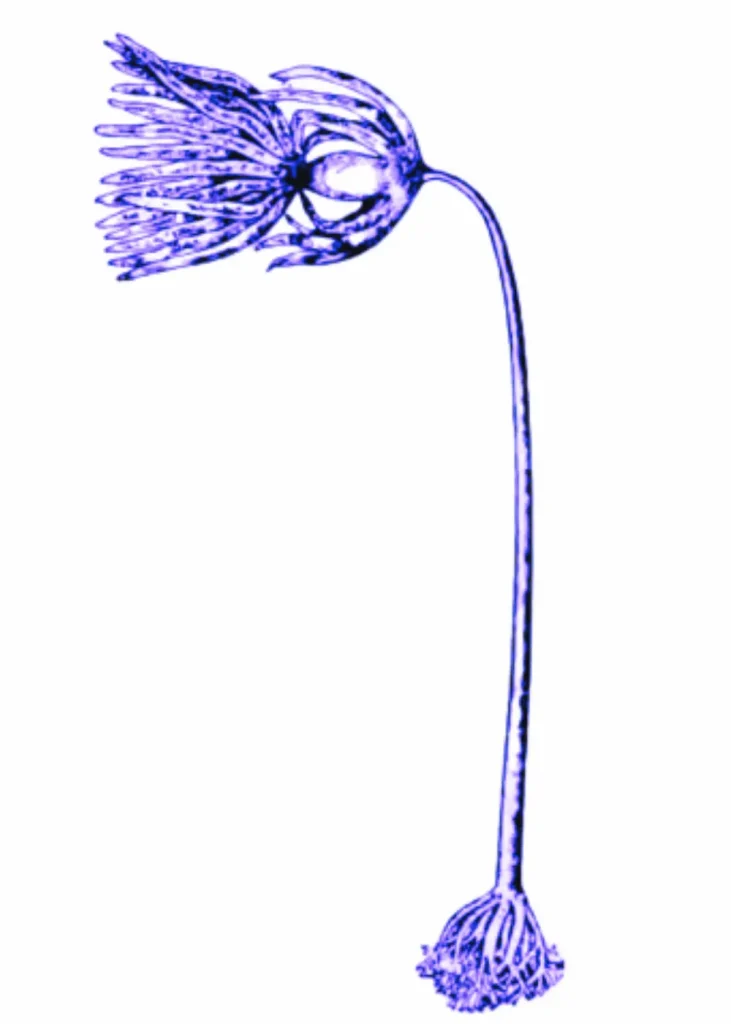
Other examples of algae with parenchymatous bodies include Chara, Dictyota, Porphyra, Laminaria, Fucus, Sargassum, and various species from the orders Laminariales, Sphacelariales, Fucales, and Dictyotales.
In some algae, such as Macrocystis, the plant body has evolved to become highly complex, even developing sieve-tube-like structures similar to those in higher plants.
Chara-like branched thalloid plant body.
Chara is a macroscopic, multicellular alga with a highly branched thallus that typically reaches a height of approximately 20-30 cm, although it can occasionally grow up to 1 meter.
The thallus comprises distinct regions, including rhizoids and a main axis. The main axis further exhibits a pattern of nodes and internodes.
Multiple branches have limited growth at each node, while occasionally, individual branches may have unlimited growth. The branches with limited growth also display nodes and internodes along their structure.
FAQs
Which is the most simple form of thallus in algae?
The most simple form of thallus in algae is the unicellular form, where the entire algal body consists of a single cell. Examples of unicellular algae include diatoms and green algae such as Chlamydomonas.
What is thallus organisation in algae?
Thallus organisation refers to the structural arrangement of the body of algae. Algae are categorized into three types of thallus organizations: unicellular, colonial, and multicellular. Each type has distinct characteristics and features.
How does the thallus of unicellular algae differ from other types?
Unicellular algae consist of a single cell that performs all vital functions. They are microscopic and float freely in water. Unlike colonial or multicellular algae, unicellular algae lack specialized tissues or organs.
What is the structure of colonial algae thallus?
Colonial algae have a thallus composed of multiple cells that are loosely aggregated. These cells may be similar or slightly differentiated. They live together in a colony and can share resources while maintaining individuality.
References and Sources
- Algae by O P Sharma
- Algae (Anatomy, Biochemistry, and Biotechnology) by Laura Barsanti and Paolo Gualtieri
- A TEXTBOOK ON ALGAE by H D Kumar and H N Singh
- THE ALGAE By V. J. CHAPMAN
- http://www.srnbdc.org/
- https://en.wikipedia.org/wiki/Thallus
